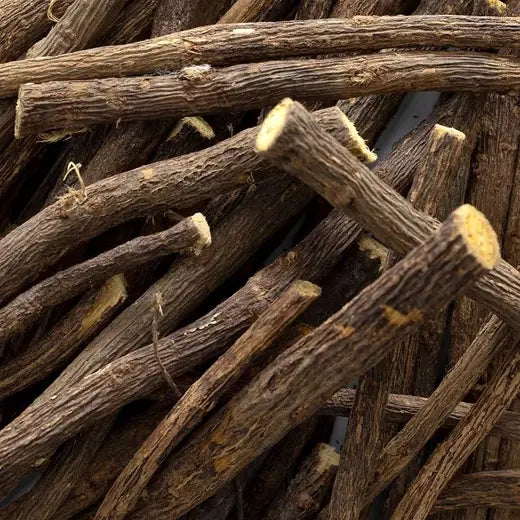THYME & SAVORY
Organic Licorice Root (Glycyrrhiza glabra)
Organic Licorice Root (Glycyrrhiza glabra)
Couldn't load pickup availability
Organic licorice sticks are best known for their sweet flavor and are used extensively in both culinary and medicinal contexts. They can be chewed directly for their sweet taste and wellness benefits, or they can be used in medicinal and culinary preparations such as teas and tinctures.
a.
quick look
information at a glance
-->| approximate cups to one pound | approx 50 sticks per pound | |
| origin | Turkey/China | |
| plant part used | root/td> | |
| processing | sticks (approx 6" in length each) |
b.
buying & keeping
general guidelines and tips
| storage tips | Keep in a well-sealed container away from direct light, heat and humidity. |
| appearance & aroma | Licorice sticks have a brown, woody exterior with a lightly golden, yellowish center. The aroma is sweet and earthy. |
c.
uses
try something new
| cosmetic | Apply a licorice root tea or infused oil to inflamed, dry skin such as in the case of eczema and psoriasis. |
| culinary | Licorice sticks can be chewed directly for their sweet, distinctive flavor or included in recipes such as teas, syrups, and candies as a natural sweetener. |
| wellness | Chewing licorice sticks may support overall oral health |
| safety | Consult a healthcare practitioner before using licorice for extended periods of time if you have high blood pressure or are taking blood pressure medication. |
d.
flavor profile
sticks of
licorice root
Sweet and spicy. Pairs well with Asian herbs and spices like ginger and star anise.
f.
what else you should know
sticks of
licorice root
The spice and herb referred to as licorice is obtained from the root of a flowering plant in the pea family that is native to Europe and Asia. While there are roughly two dozen species of licorice distributed throughout its native range, Glycyrrhiza glabra is specific to Europe where, with the exception of Scandinavia, it’s commonly found in open pastures and other undisturbed places.
The flavor and fragrance of licorice root is easily recognized due to its unique characteristics. However, what most people know as licorice candy is actually flavored with anise oil with licorice acting as a secondary flavor and sweetener. In terms of the latter, licorice is up to 50 times sweeter than cane sugar due to the presence of the compound glycyrrhizin.


